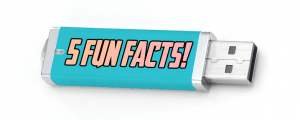USB drives. The best invention of all time. Right?
Okay, so maybe there are a couple of contenders out there, but imagine going back to the world before the advent of the Universal Serial Bus. Moving even a small file from one computer device to another was a total headache and took way longer than it should. It’s easy to forget just how ubiquitous USB devices have become in our daily lives and the technology behind them is becoming smarter, faster and stronger for each passing day. With USB 3.0 flash drives now widely available, file transfers are now completed at lightning speed while advanced WiFi and optical devices run smoother than ever without any hickups.
While we are on the subject, let’s explore a few selected lesser known facts about our favorite invention. We bet that you didn’t know these following 5 facts about USB drives! Oh, and no cheating or you’ll have to go back to USB 2.0 for a whole week.

1 – How long does a USB flash drive last? Or do they last forever?
If you are using a normal USB flash drive, don’t expect it to stay alive for all eternity. It is estimated that a normal USB flash drive will last for approximately 10 years or between 10 000 and 100 000 uses depending on the type and quality. That is to say, each time you do something with the USB drive, you consume one of these uses. This includes both downloading or uploading to the USB drive. But have no fear, you don’t have to count your uses like a madman. At any normal rate, the USB drive will likely break from construction errors or even accidents before being worn out. It is still a good idea to transfer your most sensitive files to a new drive once in a while if the content is valuable to you. They are not an ideal choice for long term file storage as the cells containing the data in the flash drive will eventually fade and get corrupted. Another cool feature of the USB is that they can withstand most scratches as well as electromagnetic interference, so even a powerful EMP is no match. Think of USB drives as the cockroaches of the technology world – they are almost immune to anything except for old age!
2 – Why are USB devices called “flash drives”?
It is easy to assume that there is some sort of moving component inside the USB device, “driving” the device. At least if the name is anything to go by. But this is not the case. The name has come from the Disc Drive, because the USB flash drive uses the same commands to control its read/write functionality as the Disc Drive. Hence, they are “drives”. USB is also sometimes referred to as a “pen drive”, because unlike discs they are shaped like pens and can be stored in your pocket. Just like a pen, right?
3 – Are USB drives secure? Can USB drives be encrypted?
As with most technology, you get what you pay for. This is of course true for USB flash drives as well. With a larger price tag usually comes better features. In the case of USB flash drives, one of these features is the ability to encrypt you data in order to keep your content secure and hidden away from intruders. This type of USB device is a must-have for companies and markets dealing in software and intellectual property such as record companies, video game and online casino developers, film studios and even book publishing companies. In some cases, all it takes for your intellectual property to be leaked into the hands of the public as well as piracy sites is for someone to gain access to an insecure USB drive. It’s better to be safe than sorry, so choose your next USB drive wisely.

4 – Who invented the USB flash drive?
Thanks to three Israeli computer engineers our lives have become much easier because of their brilliant invention, the USB flash drive. The three engineers, working for technology developers M-systems, were named Dov Moran, Amir Ban and Oron Ogdan. Thanks guys!
5 – What is the worlds fastest USB stick on the market?
If you consider that governments, intelligence agencies and military compounds around the world probably carry technology not yet available to the public, it is impossible to say which USB flash drive is the fastest in the world. But we can at least look at the consumer market and there are some truly impressive flash drives to choose from. One in particular that stands out now in August of 2020 is the SanDisk Extreme Pro SDCZ880 if you are looking for some seriously high write speed. If you are on the hunt for a USB drive with outstanding read speed you might want to check out the Corsair Flash Voyager GTX. Both of these USB flash drives have write and read speeds of around 400MB/S. Both of them can be found for sale at most of your favorite online stores such as Amazon. Keep in mind that this technology is constantly improving, so when we look back at this article in a couple of years or so, we might look back at this like ancient technology. Who knows what the future of tech holds in store, and what USB 4.0 will bring to the table!

